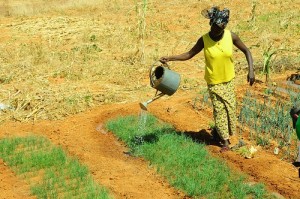Africa: Green Cities & the Challenges of Urbanization
Sep 24th, 2012 | By admin | Category: Food and Hunger/AgricultureBy Suzanne York, www.howmany.org
It is estimated that globally, every two seconds, two people move into cities. Currently twenty-two percent, or 1.5 billion people, live in 600 cities around the world.
Africa is home to the fastest growing countries in terms of population growth. It is projected that the continent will double from 1.1 billion people today to 2.3 billion by 2050. And half of that number will be urbanized. By the end of the current decade, 24 of the world’s 30 fastest growing cities will be African.
In sub-Saharan Africa, where current total fertility rates remain high, the urban population will double, to almost 600 million people.

(photo credit: CGIAR Climate, http://www.flickr.com/photos/cgiarclimate/5217859278/sizes/m/in/photostream/)
A new report by the Food & Agriculture Organization (FAO) states that “Africa’s urban population is growing faster than that of any other region, but many of its cities are not keeping pace with the increasing demand for food that comes with that growth.”
The report, called Growing Greener Cities in Africa, is focused on urban and peri-urban horticulture and underscores the need to address food security around the world, especially as it becomes more urbanized.
What is needed, according to the FAO, is to “re-imagine” how African cities should grow. The reasons for doing so are stark:
- Africa has the world’s biggest slum population – 210 million people, or 52% of the continent’s
- Half of Nairobi’s slum children are chronically malnourished;
- 200 million urban residents live on less than US$2 a day;
- 180 million have inadequate sanitation, 50 million unsafe drinking water.
The challenge is to “steer urbanization from its current, unsustainable path towards healthy, greener cities that ensure food and nutrition security, decent work and income, and a clean environment for all their citizens.” To overcome this and prepare for the increase in population, the FAO recommends creating market gardens, which it defines as the irrigated commercial production of fruit and vegetables in designated or other urban areas. In addition to providing sustenance, market gardens can protect fragile areas and contain urban sprawl.
This may not be what first comes to mind, but deeper probing shows that gardening is what many Africans either already do, based on traditional approaches focused on improving families and communities and respecting the environment. This includes sustainable agriculture, home gardens, micro-gardens, and rainwater harvesting. Much of the produce is cultivated organically and uses less water.
For example, in Malawi, 700,000 urban residents practice home gardening to meet their food needs and earn extra income.
Unfortunately these approaches have had little support or even recognition from the government in the past.
One key is keeping land in the hands of people and not industry. This is compounded in Africa in particular right now, as the number of land grabs is increasing, whereby corporations, investors, and governments buy up agricultural lands. This marginalizes and disempowers local people, pushing them off ancestral lands. And as more people move into cities, the urban boundaries expand at the expense of farmland and wild lands.
The FAO makes some useful and worthwhile recommendations, which range from self-managed cooperatives to drip water irrigation. Initiatives like these are occurring more and more often in countries all over the world – both developed and developing – with success, as increasing food and energy prices drive people to find new solutions and resurrect old tried and true practices.
Yet one major piece overlooked in this FAO report is how to stabilize population growth through positive efforts, thereby preventing some of the problems posed by urbanization. Population projections are just that – projections – and there are steps that can be taken that will better the lives of Africans and reduce resource pressures.
Some of the most effective ways to address population issues include the following: meet the high level of unmet need for family planning and make contraceptives affordable and universally accessible; increase funding for family planning; provide comprehensive sexual and reproductive health education for youth; strengthen healthcare systems (and bring services to rural communities); end child marriage; keep girls in school; shift to universal secondary education; and support viable economic livelihoods.
Africans are facing a host of serious problems, exacerbated by a growing population. Poverty, malnourishment, high rates of maternal mortality, and slums are some of the worst, complicated by gender inequality, weak land rights, and a long history of colonialism. As the continent’s cities grow and food security becomes a critical issue, Africans should turn to community and traditional solutions, innovative approaches, and family planning, and thus empower its people to take control of their resources and well-being.
Suzanne York is a senior writer with the Institute for Population Studies/HowMany.org
